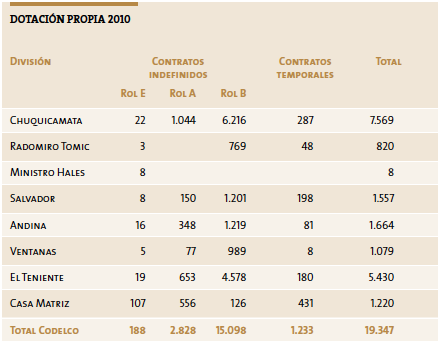Human Resources and Governance

A person’s talent, together with asset quality, give Codelco a solid position in an increasingly challenging market.
The Company’s human resources strategy is to create a competitive advantage by combining the people, the organisation and its culture, in the context of the major investment projects Codelco will develop during this decade.
In 2010, some of the actions in this strategy were as follows:
Organisational structure
Top-level organisational structures were formulated to increase coordination and communication between areas, generating speed and efficiency in the Company. Key changes were:
- Creation of North and Centre-South Operations Vice-Presidencies to reinforce safety, and meet production and cost goals; and also be the operational counterpart for the development projects.
- Creation of the Administration and Finance Vice-Presidency, as the financial counterpart of Codelco operations and projects.
- Strengthening of the Human Resources Vice-Presidency, in recruit ment, talent management, mobility, knowledge management, workforce renewal and improved work practices.
- Restructuring of Codelco Norte Division into Chuquicamata Division and Radomiro Tomic Division, to focus effort to face different challenges.
- Creation of Ministro Hales Division to develop and operate the deposit.
Executive management
New executives were appointed to Codelco’s senior management. A specialised and selective search for national and international professionals for senior management was launched.
Workforce renewal
The average age of Codelco’s workforce is 47, around 7 years more than the average age of the company’s competitors, giving Codelco an advantage in experience and knowledge. However, the company has an ageing workforce, which if projected to the start-up of structural projects it would mean that most people would be at retirement age.
To face the need to renew the workforce, an early retirement plan was set for divisions and Head Office, and agreements were reached with the corresponding trade unions.
At the end of 2010, approximately 2,200 people, mainly at retirement age or close to retirement, opted for the benefits of this early retirement. The plan included knowledge retention measures for key positions.
In 2011, the Company expects to replace a fraction of retirees, with a talent attraction strategy, including internships, graduate, expert and emerging leader schemes. The common denominator of these schemes is to attract young talent. There has also been interest to identify women, to promote more female participation in the mining sector.
Talent management
This programme aims to identify and manage knowledge within Codelco, ensure succession of key positions and those that will foster their future projection.
250 critical positions were identified in 2010, of which 178 are mining, metallurgical and geological experts and the rest are in staff and support area.
A talent review was conducted across all divisions, 577 professionals (16%) were identified. The average age of this talent is 40 and 13% are women.
Recruitment and development
An integrated system was implemented with the following elements:
- Staff planning: determine the number and skills required by the company, and also identify the gaps in the labour market.
- Availability of human capital: its mission is to develop a supply of skilled personnel; attract and retain talent, and position Codelco as one of the most attractive places to work at, both nationally and internationally.
- Recruitment and selection: ensure capturing the best talent in the market based on standards of excellence.
- Training: add skills required by the business.
- Development: identify talent with potential for senior-level positions.

Labour relations
Good labour relations led by management and trade union leaders resulted in successful collective agreements at Salvador Division, Union A and Union B; Radomiro Tomic Division, Union B; Chuquicamata Division, Miner’s Union B, and El Teniente Division, Union A.
 2011 work agendas were agreed with the Federation of Copper Workers (FTC) and the Federation of Supervisors and Professionals Codelco-Chile (FESUC).
The National Association of Copper Supervisors (ANSCO) and management participated in the ANSCO 2010 seminar: the Leader’s Role, Building our Future.
Productivity and quality of working life
Various initiatives promoted productivity and quality of working life, particularly focused on educational, selfcare, healthy eating and physical activity at work programmes.
Absenteeism was down from 5.59% in 2005 to 3.84% in 2010. Overtime fell from 6.44% in 2005 to 2.97% in 2010. As for drug and alcohol prevention, 3,042 random and pre-employment tests were conducted.
Structural projects
In 2010, the Company approved the first structural project it will implement to face long-term challenges. The Ministro Hales Division was created, based on a resource management proposal that incorporated the Company’s best practices, as well as improvements and innovations in line with future challenges.
In 2010, the organisation began a staffing process which was primarily focused on searching for synergy and collective work, where values, performance with consequences, permanent development opportunities and market compensations, aim to attract the best talent in the mining sector.
Workforce
In 2010, Codelco’s employees totalled 19,347 people, of which 18,114 have indefinite contracts and 1,233 have temporary contracts. The table below shows the workforce breakdown.





